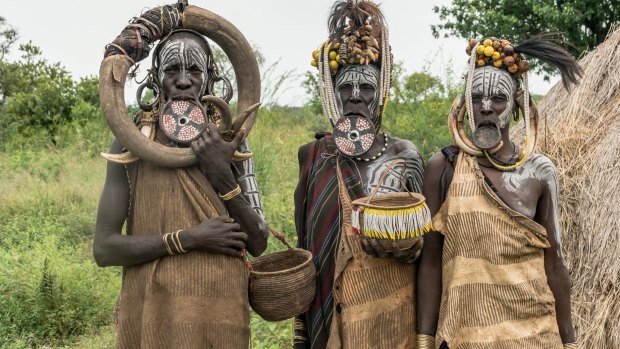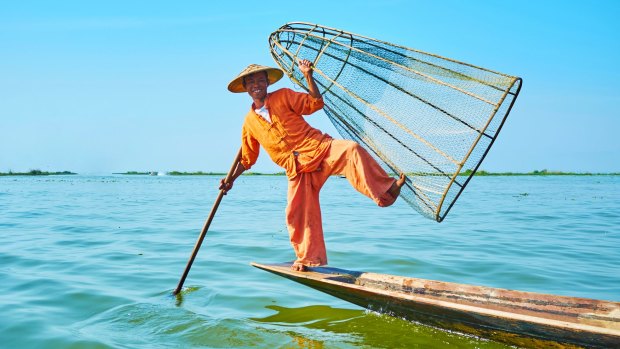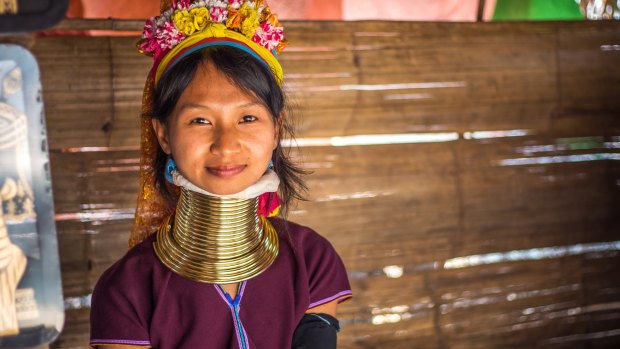This was published 5 years ago
Is it OK to pay locals in traditional dress for permission to take a photo of them?
By Michael Gebicki

The tribes of Ethiopia's Omo Valley, who practice a particularly exotic form of body art, are now dressing up solely for the camera-toting tourists rolling into their villagesCredit: Shutterstock
Our cruise ship has just berthed at the mouth of the Sepik River in Papua New Guinea and we're watching villagers perform a dragon dance. The dragon, an enormous red face at the head of a human caterpillar, weaves between the palm trees to the music of hand drums and chants. The villagers are painted and decorated for the occasion with cassowary-feather headdresses and necklaces of cowrie shells and teeth. The children wear skirts of dyed grass.
It's a full-blooded romp, a martial celebration of power and manly pride, and it's impossible not to be reminded of the head-hunting parties that were once celebrated in these villages. We buy stuff. Masks, drums, necklaces, story boards. And we take photos. Lots and lots of photos.
There's something tricked-up about all this. While this is a performance associated with village traditions in this case they're dressed up and performing for our benefit alone because they've been paid to do it. It's good-natured but it's staged.

Some of the Intha leg rowers of Myanmar's Inle Lake now depend on tourists with cameras to supplement their income.Credit: Shutterstock
They smile for the cameras, storm obligingly back and forth across the grassy spine that forms the centrepiece of their village, chanting, whooping and pounding hand drums for all they're worth, but for some of us it jars. Have we, in monetising one of their traditions, devalued something culturally significant?
Suppose the boot was on the other foot and an Australian cleric was told to frock up, parade around with the sacred objects of their faith and pose obligingly for foreigners' cameras in exchange for cash. Or the local schoolchildren, made to perform in a Kim Jong-un style parade?
Is this exploitation? A photographer suggested as much in an article in The Guardian, citing the fact that the tribes of Ethiopia's Omo Valley, who practice a particularly exotic form of body art, are now dressing up solely for the camera-toting tourists rolling into their villages with increasing frequency.

The Kayan women of Myanmar, who encircle their necks with coils of brass until they become elongated, are a highlight for many tourists.Credit: Shutterstock
"The fancy-dress parade I witnessed in Regiya fuels fantasies of exoticism, but is performed solely for the benefit of the visitor who pays for the privilege of photographing it," wrote British-based Matilda Temperley.
Is the photographer on the money when she quotes Susan Sontag on the "predatory nature of the photographic act"?
One of the effects of tourism has been the commodification of peoples with photogenic habits and traditions. Whether it's the costume of the Blue Men of Morocco, the body art of New Guinea's tribal cultures or the distinctive architecture of the Dogon people of Mali, the chance of remaining off the radar is close to zero.
Sooner or later a photographer with a taste for exotic ethnology will roll in, the shots will appear, curiosity is aroused and the tourist buses, vessels or helicopters will follow.
So it is that hill tribes of northern Thailand, the Rabari cattle herders of north-west India and the ochre-red Himba women of northern Namibia have become photo fodder. We travel to capture their images – and they quickly catch on to the commercial possibilities. Some of the Intha leg rowers of Myanmar's Inle Lake now depend on tourists with cameras to supplement their income, since catches of fish are much smaller than they once were.
There's an upside to this. If we pay to photograph them and some of that money dribbles into their pockets, what's wrong with that? Bearing in mind that many of these people are dirt-poor subsistence farmers or fishermen, hunter-gatherers or nomads whose lives are being squeezed by climate change, habitat loss and population pressures. It might pay for medicines or education or a better place to live.
But it can have unintended consequences. The Kayan women of Myanmar, who encircle their necks with stacked coils of brass until they become freakishly elongated, earning them the name the "giraffe women", are a highlight for many tourists, and so a practice that distorts and damages the collar bones is encouraged because it generates income.
The most accessible of the Kayan live in north-western Thailand, refugees from their homeland across the border in Myanmar. They have no rights to citizenship in Thailand, and little protection under the law. Some are corralled in their muddy villages by Thai middlemen who arrange group tour visits and siphon off most of the fees the tourists pay while the Kayan are kept in picturesque semi poverty.
There's irony in this as well. For better or for worse, the cash you pay for photos will bring change. It's a simple fact that the circumstances that allow a Third-World culture to cling to archaic ways often go hand-in-hand with grinding poverty. When cash comes in the front door the thatched roof on their house is replaced with a corrugated iron roof, mud brick gives way to concrete blocks, tribal costumes to jeans and T-shirts – and some of the magic is gone. In paying for pictures, the fragile world you've come to capture has evaporated.
See also: Places where photography is banned
See also: How the selfie is ruining travel
Sign up for the Traveller Deals newsletter
Get exclusive travel deals delivered straight to your inbox. Sign up now.